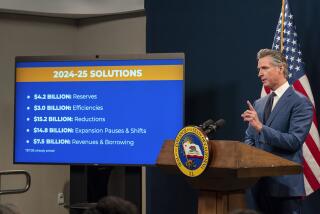Boosting Deficit Is ‘the Wrong Direction,’ State Analyst Says
SACRAMENTO — Gov. Arnold Schwarzenegger’s proposed budget “moves the state in the wrong direction” by adding billions to the deficit, the state’s budget analyst said Thursday, and the bold public works plan he announced last week relies on money that may never materialize.
“We’re expanding spending at a time when we have a significant state budget problem,” said nonpartisan Legislative Analyst Elizabeth G. Hill, to whom lawmakers of both parties look for advice on such matters.
She said the spending plan that lawmakers ultimately approve for fiscal 2006-07 should “focus more on paying down existing debt before making expansive new commitments.” The new budget takes effect July 1.
Hill also expressed concern that the governor’s 10-year, $222-billion plan for shoring up California’s roads, waterways and other infrastructure may never get the federal funds it envisions. Some of the state money assumed in the plan is likely to be claimed for other needs, she added, and local investments needed for the program are far from guaranteed.
After two years of insisting on budgets that would shrink the state’s chronic, multibillion-dollar deficit, Schwarzenegger went in the other direction Tuesday, presenting a $125.6-billion election-year spending proposal. His plan would significantly increase money for education and transportation, leaving the state to spend $6.4 billion more than it produces in projected revenue.
Much of that spending would be permanently locked into the state budget by law. It would leave deficits as large as $9.7 billion in each of the next three years.
Administration officials described the governor’s proposed budget as a responsible plan. They said it would use billions of dollars in new state revenue that was unexpected this year to help pay for new programs. They acknowledged that although the plan would leave the state with a chronic budget imbalance -- forcing lawmakers to make cuts or raise taxes in future years -- it is possible that the economy would continue to improve, wiping out those deficits.
“By any measure I am familiar with, we are moving in the right direction,” said Department of Finance Director Mike Genest. “There is quite a bit of money in the general fund. To try to reduce programs when we don’t absolutely have to is not prudent.”
Genest noted that most of the new spending would go to education. The governor’s budget includes $1.7 billion for schools beyond what the law requires, and he said that reflects the will of the people. In November, voters soundly defeated a ballot initiative for which Schwarzenegger campaigned that would have restrained school spending.
“Not only does the governor think that it is essential to do,” Genest said of the new school spending, “but I think the people spoke pretty clearly about that in November.”
Legislators, however, said they shared the legislative analyst’s concerns.
Assembly Budget Committee Vice Chairman Rick Keene (R-Chico) said lawmakers “must get serious about eliminating California’s ... deficit” before they sign off on the governor’s proposal to borrow tens of billions to invest in freeways, levies and school buildings.
GOP lawmakers have been uncharacteristically blunt in their criticism of Schwarzenegger as he seeks to move to the political center ahead of November’s gubernatorial election.
Republicans say they are worried that all of the new spending could force a tax increase in coming years. They are pushing for program cuts.
Democrats, though reluctant to criticize much of the new spending, say they too are concerned about adding to the state’s chronic budget deficit.
“I am not very happy about it,” said Assembly Budget Committee Chairman John Laird (D-Santa Cruz). He questioned whether the state can afford a $428-million after-school program that will be launched this year. Voters approved the program in 2002, when it was a ballot measure championed by Schwarzenegger before he ran for governor.
On the issue of public works projects, the analyst praised the administration for trying to plan for the long term, but said the governor’s 10-year proposal is incomplete and relies on some “questionable assumptions.”
“It is not clear at this time what specific projects and types of capital improvements are to be funded,” Hill’s report said. She noted that the administration has yet to complete a legally required needs assessment that would help lawmakers prioritize projects. That report is not scheduled to be completed until March.
The lack of information would make it difficult for lawmakers to move as quickly as they had hoped to get the first round of borrowing on the ballot. Earlier in the week, Senate leader Don Perata (D-Oakland) said it would be extremely difficult to bring any of the plan to voters before November.
Genest said that the needs assessment was nearing completion, but that it was important for the administration to present its vision before breaking it down into specific projects.
The plan would use $68 billion in bonds over the next decade as seed money for the $222 billion in infrastructure spending. That includes $13 billion of state transportation money to add freeway lanes, commuter rail lines and bike paths. But Hill said it was “highly unlikely that the total amount would be available” because the law directs much of it to local governments for building and fixing streets.
The infrastructure proposal also assumes that the state could use about $21 billion in federal funds and local government money for flood control and water supply projects. But it is unclear whether local governments will want to invest that much, and the state has had trouble securing federal money for past water projects.
“This level of federal and local investment is uncertain,” Hill’s report states.
More to Read
Get the L.A. Times Politics newsletter
Deeply reported insights into legislation, politics and policy from Sacramento, Washington and beyond. In your inbox three times per week.
You may occasionally receive promotional content from the Los Angeles Times.











